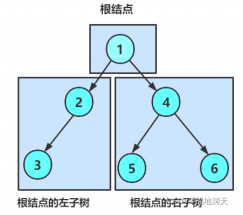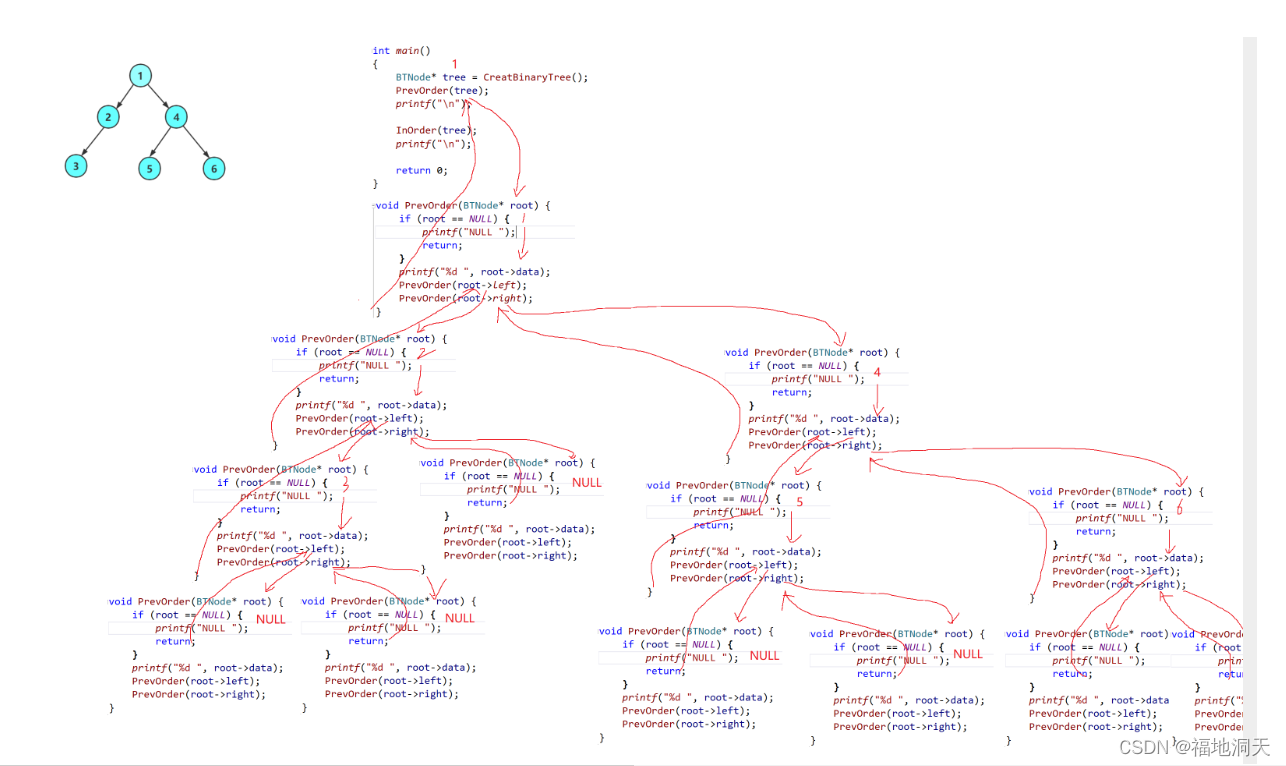- 1我的春招实习+秋招总结【前端开发】_前端找不到实习秋招是不是完了
- 2解决:fatal:unable to access‘https://github.com/xx/xx.git/‘:OpenSSL SSL_read:Connection was reset errno_fatal: unable to access
- 3数据中心GPU集群高性能组网技术分析
- 4LIama3 五一超级课堂 前置知识VScode 远程连接开发机_liama3 使用指南
- 5备忘: 使用langchain结合千问大模型,用本地知识库辅助AI生成代码_langchain和本地大语言模型 摘要提取
- 6PTA 7-9 树层次遍历_我们已知二叉树与其自然对应的树相比,二叉树中结点的左孩子对应树中结点的左孩子,
- 7MySQL数据库之索引_mysql 索引文件
- 8AI探索测试未来:人工智能与自动化测试的结合实战,文末实用干货自行领取!_面向未来的ai自动化测试工具
- 94.0 树莓派做下位机播放视频、控制电机舵机、超声波检测、paj7620手势传感器控制,树莓派串口通信等程序分析_树莓派 播放视频
- 10AITM2-0007 比光密度测定_aitm 2.0007下载
【数据结构】二叉树--链式结构_数据结构找树的叶子节点的算法
赞
踩
普通二叉树增删查改没有价值,单纯为了存储数据,不如使用线性表。
学习普通二叉树是为更好的控制它的结构,为后续学习更加复杂的搜索二叉树打基础。
平衡二叉树:AVL树,红黑树。
二叉树的概念:
1.空树
2.非空:根节点,根结点的左子树,根结点的右子树组成。
二叉树的概念:
1.空树
2.非空:根节点,根结点的左子树,根结点的右子树组成。

根据概念可知:二叉树定义是递归的,因此后续基本操作按照递归进行。
二叉树的遍历
前序,中序,后续遍历

模拟遍历
1.前序遍历(先根遍历):根 左子树 右子树
1 2 3 4 5 6
2.中序遍历(中根遍历):左子树,根结点 ,右子树
3 2 1 5 4 6
3.后序遍历(后根遍历):左子树,右子树,根
3 2 5 6 4 1
层序遍历:1 2 4 3 5 6
模拟实现二叉树遍历
构建链式结构
- typedef int BTDataType;
-
- typedef struct BinaryTreeNode
- {
- struct BinaryTreeNode* left;//左树节点
- struct BinaryTreeNode* right;//右数节点
- BTDataType data;//节点值
- }BTNode;
- BTNode* BinaryTreeFind(BTNode* root, BTDataType x);
- BTNode* BuyBTNode(BTDataType x)
- {
- //malloc节点
- BTNode* tmp = (BTNode*)malloc(sizeof(BTNode));
- if (tmp == NULL)
- {
- printf("malloc failed!\n");
- exit(-1);
- }
- BTNode* node = tmp;
- node->left = node->right = NULL;
- node->data = x;
- return node;
- }
- //手动创建链式二叉树
- BTNode* CreatBinaryTree()
- {
- BTNode* node1 = BuyBTNode(1);
- BTNode* node2 = BuyBTNode(2);
- BTNode* node3 = BuyBTNode(3);
- BTNode* node4 = BuyBTNode(4);
- BTNode* node5 = BuyBTNode(5);
- BTNode* node6 = BuyBTNode(6);
-
- node1->left = node2;
- node1->right = node4;
- node2->left = node3;
- node4->left = node5;
- node4->right = node6;
-
- return node1;
- }

1.前序遍历
基本思路:根 - 左数- 右数
- void PrevOrder(BTNode* tree)
- {
-
- if (tree == NULL)
- {
- printf("NULL ");
- return;
- }
- printf("%d ", tree->data);
- PrevOrder(tree->left);
- PrevOrder(tree->right);
- }

![]()
2.中序遍历
左子树 - 根结点 - 右子树
- //中序遍历
- void InOrder(BTNode* tree)
- {
- if (tree == NULL)
- {
- printf("NULL ");
- return;
- }
- InOrder(tree->left);
- printf("%d ", tree->data);
- InOrder(tree->right);
- }

![]()
3.后序遍历
左子树- 右子树- 根
- //后序遍历
- void NextOrder(BTNode* tree)
- {
- if (tree == NULL)
- {
- printf("NULL ");
- return;
- }
- NextOrder(tree->left);
- NextOrder(tree->right);
- printf("%d ", tree->data);
- }
![]()
4.求节点个数
a.遍历+计数
第一种:
- 1.遍历+计数
- void BTSize(BTNode* tree, int* pCount)
- {
- if (tree == NULL)
- return;
-
- (*pCount)++;
- BTSize(tree->left,pCount);
- BTSize(tree->right, pCount);
- }
第二种:
定义一个全局遍历的计数器或者static定义一个静态局部变量。
- int count = 0;
- int BTSize(BTNode* tree)
- {
-
- //static int count = 0;
- if (tree == NULL)
- return count;
- count++;
- BTSize(tree->left);
- BTSize(tree->right);
-
- return count;
- }
但这有一个致命的错误,多次调用返回的节点个数会错误。


原因:全局变量和静态局部变量都没办法没初始化为0。
b.分治:
分治思想:将复杂的问题分成规模更小的子问题,子问题再分为更小的子问题,……
方法:计算完左子树的节点个数再加上右节点的个数。
思想:递归
- //分治
- /*把复杂的问题,分成更小规模的子问题,子问题再分为更小的子问题……*/
-
- //左子树算完再算右数再加上根节点
- int BTSize(BTNode* tree)
- {
- if (tree == NULL)
- return 0;
- return BTSize(tree->left) + BTSize(tree->right) + 1;
- }
5.求叶子节点的个数
分治:计算完左树再计算完右树。
代码:
- //求叶子结点的个数
- //分治
- int BTreeLeafSize(BTNode* tree)
- {
- if (tree == NULL)
- return 0;
- if (tree->left == NULL && tree->right == NULL)
- return 1;
- return BTreeLeafSize(tree->left) + BTreeLeafSize(tree->right);
- }
6.求第k层节点的个数
思路:将第k-1层的作为父亲节点,递推。
- //第k层节点的个数
-
- int BTreeLevelSize(BTNode* tree,int k)
- {
- assert(k >= 1);
- if (tree == NULL)
- return 0;
- if (k == 1)
- return 1;
- //找到k-1层作为父亲节点,计算即可
- return BTreeLevelSize(tree->left,k-1) + BTreeLevelSize(tree->right,k-1);
- }
7.问树高几何?
分治:计算左子树高度和右子树高度作比较,大的那个+1
- //求树高几何?
- int BTreeDepth(BTNode* tree)
- {
- //分治,左数算出高来,右数算出高来,比较取其大者
- if (tree == NULL)
- return 0;
- return BTreeDepth(tree->left) > BTreeDepth(tree->right) ? BTreeDepth(tree->left) + 1 : BTreeDepth(tree->right) + 1;
- }
8.二叉树查找值为x的节点
- 思路:1)考虑分治思想,先递归左树,再递归右树。
- 2)找到就返回对应节点地址,炸藕到就返回NULL
- 3)判断返回的是为NULL 还是 对应的节点。
- //二叉树查找为x的节点
- BTNode* BinaryTreeFind(BTNode* root, BTDataType x)
- {
- if (root == NULL)
- return NULL;
- //前序遍历
- if (root->data == x)
- return root;
- //先遍历左树
- BTNode* ret1 = BinaryTreeFind(root->left,x);
- if (ret1)
- return ret1;
- //遍历右树
- BTNode* ret2 = BinaryTreeFind(root->right, x);
- if (ret2)
- return ret2;
- return NULL;
- }

9.层序遍历
思路:根据层序遍历的特性,可以使用队列解决。
当取出上一层的数据的时候,将上一层对应的left 和 right 入队列。
注意:C由于没有库,要取出我们之前自己实现的队列的文件,添加在该项目的相应位置。
记得在Queue.h上加入

入队列的时候,入的是二叉树的一整个结构体,不单单是data
代码:
- //层序遍历
- /*根据层序遍历的特性,考虑将数据入队列,可以根据队列的性质,实现层序遍历
- 当取出上一层数据的时候,将left 和 right 节点依次入队列*/
- void LevelOrder(BTNode* tree)
- {
- //创建队列
- Queue q;
- QueueInit(&q);
-
- //树不为空,入队列
- if (tree)
- {
- QueuePush(&q,tree);
- }
- //将数据入队列。
- while (!QueueEmpty(&q))
- {
- BTNode* front = QueueFront(&q);
- QueuePop(&q);
- printf("%d ", front->data);
-
- //如果左子树不为空,入队列
- if (front->left)
- QueuePush(&q, front->left);
- //如果右树不为空,入队列
- if (front->right)
- QueuePush(&q, front->right);
- }
- printf("\n");
- //销毁队列
- QueueDestory(&q);
- }

10.判断二叉树是否为完全二叉树
思路:判断还是以队列为基础,层序遍历为辅。
入队列时,NULL也入队列,当出队列的时候遇到NULL时,开始将剩下的队列数据除队列,当剩下的数据中只有NULL时,则说明其是完全二叉树,否则就不是。
画图:

这棵树就不是完全二叉树。
代码:
- //判断二叉树是否为完全二叉树
- /*以队列为基础,层序遍历为辅助,当遇到NULL时,将剩下的数据都出队列,当剩下的数据中只有NULL,
- 则说明是完全二叉树,否则就不是文强案二叉树*/
-
- bool BTreeComplete(BTNode* root)
- {
- Queue q;
- QueueInit(&q);
- //若不为空,入队列
- if (root)
- QueuePush(&q, root);
- while (!QueueEmpty(&q))
- {
- BTNode* front = QueueFront(&q);
- QueuePop(&q);
- //为空时跳出
- if (front == NULL)
- break;
- //入队列
- QueuePush(&q, front->left);
- QueuePush(&q, front->right);
- }
- while (!QueueEmpty(&q))
- {
- BTNode* front = QueueFront(&q);
- QueuePop(&q);
- if (front)
- return false;
- }
- return true;
- }

11.销毁树
思路:递归分治,销毁左子树 - 右子树 - 根
- void BTreeDestroy(BTNode* root)
- {
- if (root == NULL)
- return;
- BTreeDestroy(root->left);
- BTreeDestroy(root->right);
- free(root);
- }
如有错误,还请大佬们指出~




